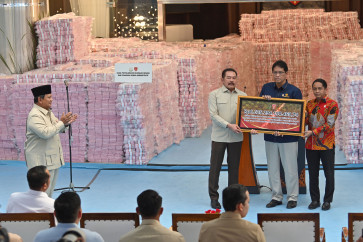Popular Reads
Top Results
Can't find what you're looking for?
View all search resultsPopular Reads
Top Results
Can't find what you're looking for?
View all search results‘Jalan Jati’ art project Nature vs Science
The Muna team around the largest teak tree in the so-called hutan hantu (haunted forest) with a group of local youth who led the team to the tree
Change text size
Gift Premium Articles
to Anyone
T
span class="caption" style="width: 558px;">The Muna team around the largest teak tree in the so-called hutan hantu (haunted forest) with a group of local youth who led the team to the tree. (Courtesy of Shannon Lee Castleman.)
“What’s the use of them having names,” the gnat said,
“if they won’t answer to them?”
“No use to them,” said Alice.
“But it’s useful to the people that name them, I suppose. If not, why do things have names at all?”
“I can’t say” the gnat replied.
“Further on, in the wood down there, they have got no names.”
(Through the Looking-Glass, Lewis Carroll)
A 1950’s teak bed found in a Singapore karang guni junk store takes a journey through the history of teak in Southeast Asia.
Along this journey, the importance of purchasing legally certified timber is valued and the different languages of science, art and local culture that surround even the most common objects are recognized.
Jalan Jati — the teak road followed by Lucy Davis and the artist collective at The Migrant Ecologies, an umbrella group for arts and ecology initiatives in Southeast Asia — started in Little India, Singapore.
Impressed by the quantity of wooden objects found in the street and in second-hand shops, Davis and the Migrant Ecologies team started wondering about how people use and re-use everyday objects.
One thing led to another and in a matter of days they were studying and classifying the objects they found in the neighborhood, putting themselves in the shoes of scientists discovering and describing nature.
“Latin names are often given to species of plants and animals quite randomly,” Lucy said. “Scientists use the location where the specimen was found, their own or their partner’s name or any other reference that comes up at the moment of naming.”
So, she thought, “If it’s so relative, then I can rename them myself!”
The “fauna and flora” of Little India got renamed by artists turned taxonomists.
By playing the taxonomy game, it soon became clear that categorization came with belief, as objects were spontaneously given names that referred to localities or stories from Little India.
The research of renowned anthropologists such as Ellen Roy has shown that the way people name their surrounding environment faithfully follows the importance they place on it. In this way, the surrounding environment is understood, perceived and used.
After naming, comes classification. The categorization process enters and mixes with the realm of cultural beliefs, social practices and economic significance.
“Jati-diri is often taken to mean identity, personality, the true authentic self or, most accurately, the essence of self,” said the language experts the artistic team consulted on the different meanings of the word jati (teak). They also learned that sejati means pure, true, authentic, original and genuine.
The Migrant Ecologies team brought this valuable information along as it set out to discover the origin of a unique teak bed they had found.
DNA tests suggested a match between a sample from the bed and teak trees on the island of Muna, Southeast Sulawesi, where the common local saying “politik Muna adalah politik kayu” (Muna politics is the politics of wood) reflects the area’s long cultural and economic ties to the teak industry.
On the island, monuments have been erected to honor majestic teak trees and roads have been named after this precious species of tree.
The Migrant Ecologies team continued its expedition and consulted a few local shaman on the same question they had asked to DNA research firm DoubleHelix Tracking Technologies – “where did this piece of wood come from?” None of the replies matched with scientific evidence. The shaman did not feel the wood was from the area and they were not convinced the DNA test was correct.
Davis and the rest of the team smiled. Their quest for the bed’s origin had brought them to the right spot.
The Jalan Jati they had taken reached the crossroads where all the paths bring to the correct location, that is the place where lies the identity of an object.
It is an identity composed by all the bits and pieces that make each object so unique through its power to evoke emotions and hide personal stories. And scientific truth is one of these paths.
— Marcella Segre










